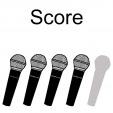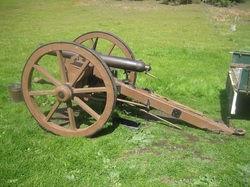|
Initial Thoughts One of the things I like most about Shure mics is, what you see is what you get. They are generally simple, effective and the term robust doesn't go quite far enough in describing how well made they are. Al of this describes the SM 57 perfectly. It is a very standard looking dynamic microphone and although it is designed more for instruments than for voice I find myself using it often when I need a mic for vocalisations. This is mainly because it has a clear pick-up with a short range so I can grumble like a troll into it and it won't pick-up the noise of the air-conditioning unit in the background. I am not sure how useful it will be for location recording and sound effects, but I am happy to test it out.  Later Observations Over some time the SM57 definitely confirmed itself as a useful mic for vocalisations; be it goblin or pixie the SM57 handles vocal ranges and sounds very well. Its obvious strength is for instrument miccing as that's what it was designed for. I seldom use a single mic when recording instruments, but I will almost always have this mic in there somewhere. Where it was surprising was for sound effects recording. It deals with high SPL sounds better than I had expected. I haven't yet placed it right at the muzzle of a gun, but I suspect it would deal with it pretty well. In many other situations it is well capable of capturing clear samples of quite loud sounds. I would not choose it for very subtle sounds, but its general recording capabilities combined with it being almost indestructible earns it a permanent place in my kit bag. In the real world The main selling point for the Shure SM57, as well as it's sibling the SM58, for my purposes is the combination of very low price and very high durability. A piece of equipment built as sturdy as a Shure microphone allows you to utilise it for more precarious situations without being concerned for the equipments safety. The low pric also means that should something unexpected happen it is not going to break the bank to replace. I try to be extremely careful with my equipment, but there are times when capturing certain sounds lends an inherant risk to the equipment you are using. The SM57 allows me to work without  Good Very good vocal / instrumental mic Practically indestructible Great price for what it is Bad It won't suit every purpose Not really suitable for very quiet sound sources Website www.shure.com Initial Thoughts Shure make microphones, Shure make very good microphones and generally Shure make microphones that are virtually indestructible. This has been Shure's reputation for many years, and the Beta 58A is not going to detract from that in any way. As an on stage piece of equipment the 58A is a reliable solid piece of equipment, as a field microphone its something that can cope with the adverse conditions that field recording will often place on precision gear. I have had a 58A for ages and never really used it. I always thought of it as a vocal microphone and as such never really thought I had need for it. More recently I discovered this was a poor assumption made at my own expense. I have recently found that the short pickup range of the 58A makes very good at picking up close range sounds without the risk of capturing unwanted background noise. This is a very different approach to using a shotgun mic, but can be just as valid. A shotgun attempts to capture only what you point it at and as such block out unwanted sounds that are “off target” The 58A has a wider response pattern, but a much shorter range, so while it may capture off target sounds, it will only capture sounds that are very close. The Beta 58A also has the trade mark Shure build quality which means you could quite literally drop it off the back of a moving car and still use it afterwards. While risky recording situations are probably better suited for its cheaper cousins the SM57 and SM58, the Beta 58A can be used confident in the knowledge that its going to cope with what you throw at it. From a vocals aspect the 58A is excellent. I use mine mainly for vocal effects, screams and creating monster sounds and I’ve found I can use it almost anywhere to capture voice beautifully cleanly with almost no background noise. This includes standing on top of an office building surrounded by noisy machinery and still capturing only the desired vocal effects. As a dynamic mic the 58A requires no extra power source Technical Data Later Observations As with the MKH 60 I have had the Beta58A for quite a few years. Unlike the MKH 60 I have not used the 58A nearly as much. I can certainly atest to the fact that as a Shure mic it is practically indestructable. As far as sound quality is concerned I have found it excellent for recording human and animal sounds at close range. At the time of writing this it was becoming one of my favourite mics until it was missplaced on a location recording trip. I have not replaced it as yet but plan to at my earliest convineinece as I am more impressed with this microphone the more I use it. In the Real World The Beta58A has the typical Shure build quality as one of tis standout features. This combined with good sound qulaity make it an excellent mic to use in situations where you might fear risking other equipment. The Beta 58A does not have the extreme SPL capabilities of more specialist microphones, but it is still capable of capturing high signal levels. This and its durability make is a natural choice when one has the opportunity to record a 100 year old Howitzer. Verdict Good Practically indestructible Good quality sound capture with surprisingly low background noise for the response pattern Bad Not quite cheap enough for me to own ten of them Website www.shure.com |



 RSS Feed
RSS Feed
